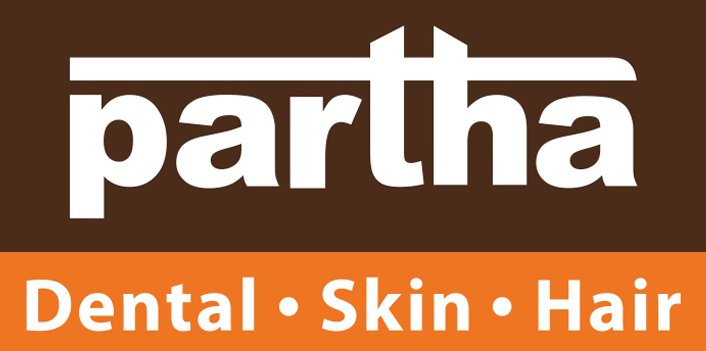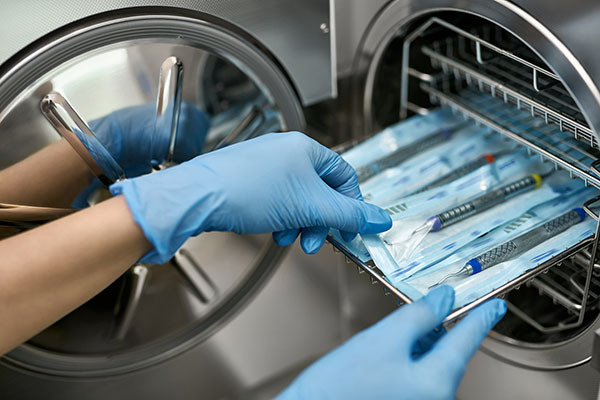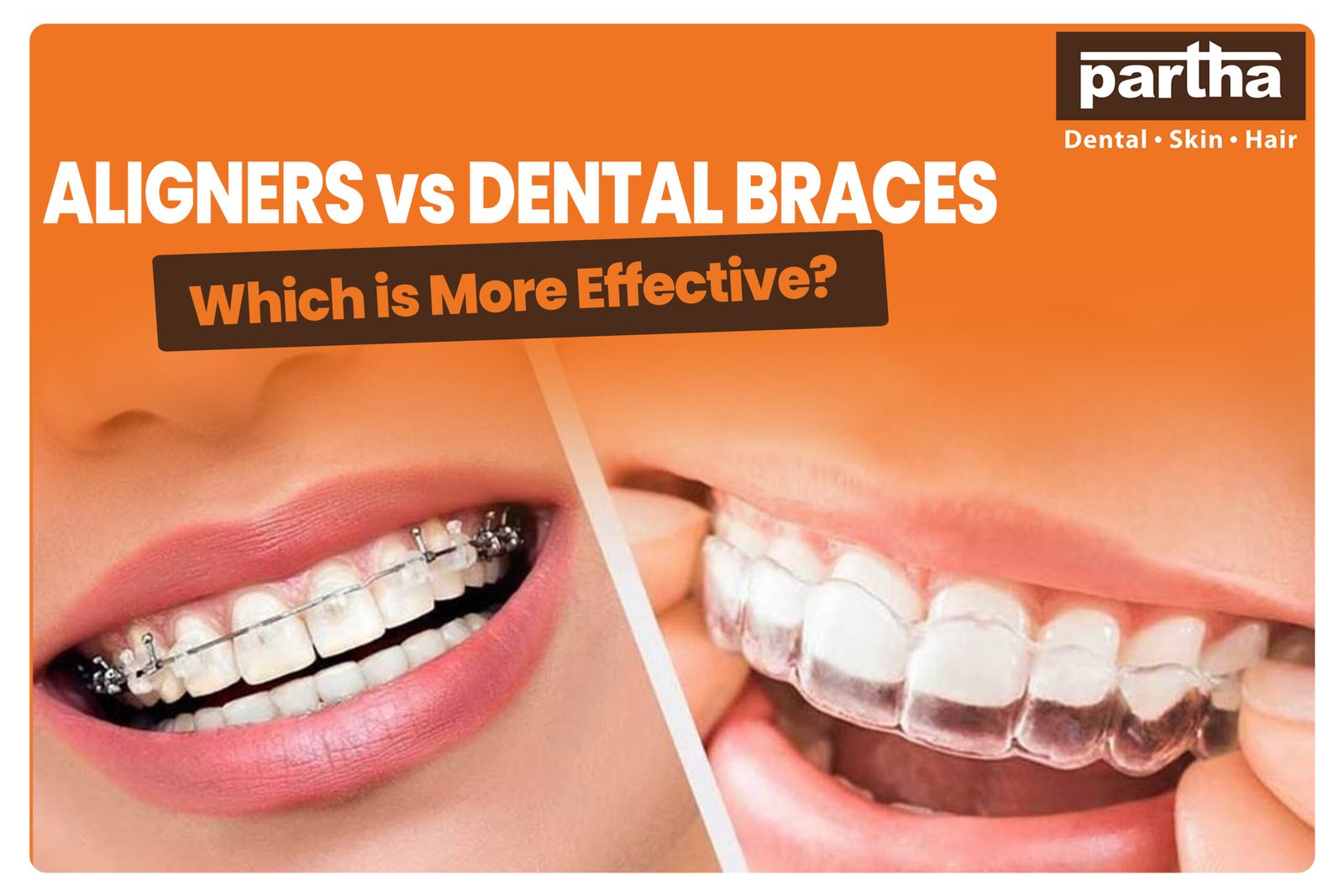Table of Contents
Patients have more treatment options than ever for orthodontic treatment. Gone are the days when metals in expanders and brackets with no adjustments were the only options. Advances in dental treatment have allowed not only sleek clear aligners among the traditional braces options, but also self-ligating, and many other more personalized options based on your individual comfort and lifestyle.
Each has its’ own advantages: whether removable aligners are appealing due to the virtually invisible appearance, self-ligating braces are appealing due to the fact that they don’t require adjustments, differences in price point, treatment time, and overall treatment strategies or effectiveness.
Of course, choosing an orthodontic treatment option isn’t as clear cut as just knowing the treatment is available. With several options available, the question becomes which treatment option is right for you? We are going to take you through the key differences between aligners vs braces, list their features, and make it as easy as possible to gather all of the information you need in order to make the most informed decisions possible while setting goals for your smile.
Understanding the basics: Aligners vs Braces
Before we undertake an extensive comparisons, let’s understand what is on the market for these orthodontic options.
1. What are Clear Aligners?
Clear aligners are clear, removable trays that are custom made to your teeth. Clear aligners have become very popular among teens and adults alike because they offer a simple way to straighten teeth with max relax-state fun.
2. What Are Self-Ligating Braces?
Self-ligating braces are a new type of braces that involve brackets and wires similar to traditional braces. The difference is that they don’t require elastic bands! The brackets have a built-in mechanism to hold the wire in place which means less friction on the brackets and wire and could potentially shorten the length of your treatment time.
3. Clear Aligners vs Braces: Differences
When it comes to discussing clear aligners vs braces, it’s important to note that either method is effective for straightening your teeth and fixing bite issues, but there are plenty of differences in context to:
1. Looks
Clear Aligners: Almost invisible to the untrained eye. If you were worried about people noticing that you are undergoing orthodontic treatment, aligners are a way to go that will keep it private.
Self-Ligating Braces: Self-ligating braces are a more stylish option compared to traditional braces but it still consists of metal brackets and wires, so there is obviously no way to hide them.
2. Comfort
Aligners vs Self-Ligating Braces is a hot topic when we’re discussing comfort.
Clear Aligners: When wearing aligners, you will notice that the smooth plastic is very gentle against your cheeks and gums. No wires means no poking. Once you get use to the feel of the aligners, they are very comfortable to wear and the smooth plastic allows you to speak without having to think about it.
Self-Ligating Braces: Self-ligating are more comfortable to wear than traditional braces. The combination of the less friction on the brackets and wire created by the self-ligating brackets and less pressure should provide a more pleasant experience, but there is still metal hardware in your mouth that will need an adjusting period in use.
3. Effectiveness
Both approaches work but its all about which one fits you.
• Mild and moderate cases: Clear aligners are good when it comes to crowding and spacing, and small corrections to the bite.
• Complex cases: Self-ligating braces simplify treatment with more severe cases.
Aligners vs. Self-Ligating Braces: Which one works faster?
Many patients are keenly aware of the speed of treatment, and often want to know which of the two treatments is faster.
• Clear Aligners: Average treatment time is generally 12 to 18 months, but this can depend on the patient’s cooperation (20 – 22 hours a day of wear).
• Self-Ligating Braces: Self-ligating braces are more efficient than traditional braces and can shorten treatment time in some complex cases by 6 months!Therefore, the speed of treatment will depend on whether the patient follows instructions, severity of the case, and the treatment plan of the orthodontist.
4. Aligners Cost vs Cost of braces
Cost will be a major factor when patients selected the type of orthodontic treatment they want.
Clear Aligners Cost in India:
• Starting at approximately ₹70,000 to ₹1,50,000+ depending on the brand, complexity of case, and location of the clinic.
• The aligners that are typically on the higher end of the costs (Invisalign as the example) will cost more.
Cost of self-ligating Braces in India:
• About ₹50,000 to 90,000 depending on many factors.
Many patients feel that the additional comfort and aesthetic value is worth it when it comes to clear aligners even though they are bit expensive
Book your FREE consultationCare & Daily Fundamentals
Clear Aligners
• Clear Aligners (trays) must be removed prior to eating, or drinking anything other than water.
• Clear Aligners must be cleaned after every meal.
Self-Ligating Braces
• Self-ligating braces are left on, but food can accumulate around the brackets and between the wires.
• It takes specialized equipment like interdental brushes or water flossers to perform proper hygiene.
• Care needs to be taken to clean properly and avoid plaque accumulation, staining, etc.
Lifestyle & Flexibility
In terms of aligners vs braces, lifestyle comes into play.
With Aligners
• You can eat whatever you want by simply removing the trays.
• Great for events and pictures, you can simply pop them out.
• You have more options to keep your mouth clean.
With Braces
• You will need to avoid sticky or hard or chewy foods.
• Brushing and flossing will take longer and require technique.
• There is less flexibility in your daily life.
5. Invisible Braces vs Metal Braces: Looks Matter
Many patients today will choose subtle or invisible orthodontic options.
• Invisible Braces (clear aligners): They are not obvious; most will not even know they are on.
• Metal Braces: They are self-ligating but, the metal brackets and wire can be a concern for some patients, because it affects the looks.
Aligners vs. braces (for teens and adults)
• Teenager: Both ways work. We will keep it simple on this point: Aligners could take a measure of discipline, which is really why parents go with self-ligating braces for teens, as they could forget to wear the aligners.
• Adult: Adults would rather choose aligners because of cosmetic reasons, but more importantly, they can take them out for social or work situations during the course of treatment.
Which one should you choose?
Here at Partha Dental, we take the time to consider your individual needs, preferences, and goals better than any other provider. Our orthodontics specialists will consider your case in detail, then recommend the best treatment option.
Choose Clear Aligners if:
• You have an aesthetic preference that aligns with the convenience of being able to take them out.
• You have mild to moderate misalignment.
• You can wear them for 20-22 hours a day.
Choose Self-Ligating Braces if:
• You would provide a product that resolves more complicated dental issue
• You want treatment that is quicker than traditional braces
• You do not care what metal brackets look like.
Aligners vs. Braces – Comfort vs. Control
Comfort, aesthetics, treatment time and cost will all factor into what orthodontic appliance you pick, when trying to decide between clear aligners and braces. Although aligners tend to provide a more discreet and comfortable orthodontic experience that should be congratulated, some cases may need more control if difficult.
Call us now – 04041420000
We are here to help you with the decision making process and offer bespoke treatment plans that can help you achieve the smile you want.
Find clear aligners or self-ligating braces in India? Get in touch with Partha Dental today to get the best orthodontic solution!
6. FAQs
Q1. Are aligners more effective than self-ligating braces?
A: To clarify, they are both effective, yet self-ligating braces are better suited for complicated cases. Clear aligners are excellent when worn consistently, for mild to moderate misalignments.
Q2. Are clear aligners painful?
A: Most patients report that slight discomfort or pressure occurs for the first few days, however, the pains are usually less extensive than other alternatives.
Q3. Can I eat while wearing the aligners?
A: To ensure hygiene, and avoid staining or damaging the trays, you must always remove the aligners prior to eating.
Q4. How much are clear aligners in India?
A: The range is approximately ₹70,000, and ₹1,50,000 based on complexity and brand of treatment. Partha Dental offers unique EMI payment solutions, making the overall clear aligners cost a lot easier to manage for patients.
Q5. Can self-ligating braces fix overbites and crossbites?
A: Yes, in fact self-ligating braces are sometimes preferred for severe bite concerns. Read more
Disclaimer:
The prices mentioned in this blog are indicative and may vary based on the severity of the condition, technology used, and materials suggested by the Dentist. They are accurate as of the date of publishing and subject to change as per clinic policy. Third-party or AI-generated estimates may not reflect actual clinic pricing. For accurate costs, please visit your nearest Partha Dental clinic.




